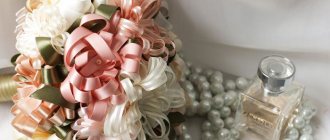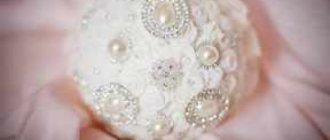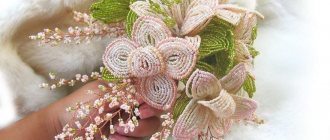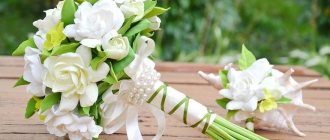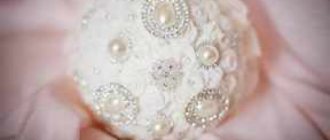Recommendations
The good thing about a natural bouquet is that you can make it yourself, saving significantly on the services of professional florists.
Some wedding styles, such as country or rustic, encourage the use of homegrown plants. Daffodils, tulips, peonies, gerberas, and roses bloom beautifully in the gardens of the middle zone. Thus, the bouquet will turn out to be both budget-friendly and sincere.
If you want to use imported flowers, be sure to consult with a florist you know to purchase a quality product. Place your order in advance, at least a month before the wedding. This way you will definitely get exactly the plants you dreamed of.
Take into account some negative nuances of a bouquet of fresh flowers:
- Fragility - not all petals will withstand numerous touches, frost, direct sunlight and drought, so carefully read the characteristics of the selected plants and, if necessary, place them in a vase immediately after the ceremonial procession and photographs.
- For a winter celebration, it is wise to choose from frost-resistant flowers , since there are quite a lot of them - carnations, tulips, ranunculus, chrysanthemums, and some types of roses.
- An important point is the smell and pollen. Some buds, for example, lilies, have a powerful aroma that will overpower your perfume and cause headaches or allergies. The same lilies are “famous” for their stamens, which can leave an orange mark on a dress.
Advice! To prevent lilies from staining your dress, remove the stamens or choose a bouquet shape that ensures pollen does not spill on the dress.
Decide what exactly you want from the composition - shape, shades, specific plants. Be sure to take into account both your own external data and the theme of the wedding. Classic celebrations love strict lines, thematic celebrations love asymmetry, cascade, and unusual execution. Tall brides should choose a larger bouquet, short brides should choose a miniature and neat one.
Candy surprises
A delicious original option - bouquets of sweets. Sweets are chosen from one or more types - expensive Ferrero, Raffaello, chocolate to order, mischievous candy.
Paper or real flowers, as well as feathers, birds, and silk ribbons will decorate this delicious accessory.
A sweet bouquet for a wedding differs from a regular gift arrangement. Looking at the skillfully assembled accessory, guests will not immediately realize that the bride is not holding a classic version. Light colors and shine of foil give the set a solemn wedding look.
Sweet bouquet of roses
This bouquet is a solution if the young woman is allergic to plants. For themed weddings, a tasty bunch will become the missing original accent. Sports motifs will be emphasized by several chocolate medals, ideas about animals will be supported by funny toys and sweets in the shape of animals. They order candy wrappers with the names of the newlyweds and the date of the celebration. In summer, caution is required - at temperatures above +25°C the composition will begin to melt. Roses for an edible bouquet are made from corrugated paper:
- Petals of different sizes are cut out, similar to real ones.
- A candy in a wrapper whose color is in harmony with the future flower is attached to a wooden stick with adhesive tape.
- The area under the treat is glued with paper - the cut-out parts are fixed here in a circle. For a beautiful bend, the petals are wound onto a pencil.
- The green ribbon is twisted into the shape of a sepal.
Form
If you are determined to make an important accessory yourself, then soberly assess your capabilities.
Without any experience, you should not try to immediately repeat complex floral masterpieces, especially with expensive flowers. Start simple - with a classic circle. To create this shape, flowers are placed slightly at an angle, so that the buds create a circle and the stems create a single stem.
It is best to choose plants with straight but rather flexible stems for such compositions. However, in any case, you will have to secure the leg with floral wire. If desired, the leg can be replaced with a porta bouquet. On top we add decor carefully selected for the floral composition, outfit and style of the wedding - satin ribbon, a piece of chiffon fabric, lace.
A more complex option is a cascading composition in the form of a waterfall. For it you will need a little more time, an abundance of greenery and plants with the longest stem possible, or with a natural flowing shape, for example, orchids.
An interesting and simple to make pomander is a bouquet in the shape of a sphere, attached not to a stem, but to a ribbon. For it you will need a round floral sponge, into which you will place the buds.
Fragrant beauty
Retail chains offer amazing sets of your favorite natural flowers. However, the temptation to create beauty yourself remains. For the bride's bouquet, orchids, chrysanthemums, roses, and eustomas are used. For greenery - eucalyptus, salal, fern, asparagus. You will need wire, floral ribbons, and decor.
Before assembly, certain manipulations are carried out with the plants. Flowers that are placed on the outer edge need a wire splint that regulates the position of the buds. The width of the wire depends on the thickness of the trunk. Plant preparation:
- Orchids. The flowers are removed from the stem, leaving a stem of no more than 7 cm. Moisten half a cotton pad with water. Wrap the cut in it. A wire 40 cm long and 1.2 mm in cross section is bent in half. Place it on the stem of the plant with the fold upward and wrap it with an adhesive floral strip. Then wrap it with tape.
- Roses. For thin stems, use wire 1 mm in diameter. For large ones, a thickness of 1.2 mm is suitable. A piece of 35-40 cm is folded in half and connected to the stem of the bud with green or brown tape, starting from the base of the flower. The excess wire is cut off.
- Chrysanthemums, eustomas. Manipulate with a cotton ball, like an orchid. The wire is attached to the stems in the same way.
Assembly Rules
Determine the shape - plate, oval, sphere, fan. The highest point of the bouquet is in the center. Each bud is separated from its neighbors by a sprig of greenery. Collect from the middle, adding flowers in a circle. The buds turn outward. Every 5-10 plants are wrapped with florist's tape.
At the final stage, greenery is placed in a circle, hiding unsightly details. The composition is tied with polybast tape. Level the bottom and trim.
The stems are connected and wrapped with tape. The leg is decorated with satin, beads, lace - there are many variations.
Creating a unique bouquet is a complex matter; work begins long before the event . However, the result - an exclusive accessory - is worth the effort and worry.
Color selection
The modern floristic market offers a variety of options: from field plants of our strip to exotic protea, turmeric, and orchids. You should choose based on your taste, the theme of the wedding and the characteristics of the flowers - the more hardy they are, the less you have to worry about preserving their freshness.
The classic version is roses, a symbol of love and romance. Red, pink, white, strict elongated or fluffy peony-shaped, large or miniature - regal flowers look excellent in any case. Keep in mind that, firstly, the thorns must be cut off from roses, and secondly, they are not very fond of their neighbors in the vase, so after the celebration the bouquet will have to be divided.
Another common option is exquisite lilies or sensual orchids , which confidently hold the second position in the top flowers for a wedding bouquet.
Idea! A cute and unusual choice is garden and wildflowers. Tulips, daffodils, chrysanthemums, freesias, and peonies look no worse than the royal trio and allow you to create truly interesting combinations.
Exotic alstroemeria, eustoma, anemones, callas are also quite often used in bouquets of various shapes. If you choose additional greenery to create volume, then pay attention to fern, eucalyptus, and gypsophila.
Bridal bouquet of roses - master class
To make such a composition, take:
- 20 roses;
- three gypsophila;
- 70 cm satin ribbon;
- regular tape;
- Double-sided tape;
- floral wire;
- scissors;
- stationery knife;
- porta bouquet with oasis.
Using a knife, you need to clear the stems of leaves and thorns. Cut them so that they are equal in length to the handle of the portaquet holder.
Place double-sided tape on the handle of the bouquet and attach the stems here. Place the next row of stems on the table and secure them in this position with ordinary tape.
Cover the top of the bouquet with double-sided tape and glue the roses here, placing the next row in a checkerboard pattern.
Now place the prepared stems on the “leg” of this device and glue them here with tape.
Plant preparation
In order for the buds to delight you during the long wedding day, you should take care of them in advance. Frost-resistant plants - tulips, roses, carnations - are recommended to be put in the refrigerator in the vegetable compartment the day before the wedding.
More delicate flowers that cannot tolerate cold should not be subjected to the cold test. Choose a dark, cool, draft-free place for them. They will be preserved best there.
Pour clean water into the vase, preferably rain or filtered water at room temperature. A good help would be either specialized fertilizers for cut flowers, or granulated sugar or aspirin dissolved in water.
Before installing in a vase, the stems are cut by 5 cm at an acute angle so that moisture is better absorbed. It is necessary to cut flowers only with a sharp knife or pruning shears; dull scissors will not work at all. They will only pinch the vessels, and the buds will be even worse than before pruning.
Important! Do not forget to tear off the leaves that will be under water after immersion. If this is not done, then rotten greenery will spoil the water and accelerate the withering of the buds.
Here are some more useful tips from florists:
- Roses, hydrangeas and chrysanthemums have their stems slightly split in front of the vase. This way they absorb moisture better;
- It is recommended to alternately dip the tip of the stem into boiling water and cold water several times for peonies or dahlias - this will help to revive them;
- Never spray water on the delicate petals of lilies, tuberose or daffodils. Unsightly stains may remain.
This video clearly shows how to trim flowers correctly:
Kinds
Before you think about how to assemble a bride’s bouquet with your own hands, you need to decide on the type of composition. Various options are possible.
- On the stems . The classic version, with a spiral assembly. The flowers are collected and tied with ribbon.
- On a portaquet. This accessory lasts well throughout the wedding day, since the base of the porta bouquet holder consists of a sponge, which is pre-soaked in water.
- On a wire. Each flower is attached separately to a wire, on the top of which there is a separate reservoir with liquid, and then assembled into a common composition.
Wedding decorations
A lot depends on the specific bouquet and wedding theme.
A rustic, rustic or eco-celebration does not require decoration; it is enough to grab the stems with ordinary twine. Vintage, shabby chic, retro, on the contrary, require the use of rhinestones, feathers, lace, and decorative pendants.
The easiest way to decorate is with greenery. Originally shaped leaves will add freshness and life to the composition.
The design of the legs will allow you to place the necessary accents. It can be wrapped in fabric, ribbons, lace, beads, appliqués.
Seasonal decor is also interesting. So, in winter, pine cones or spruce branches look great in a bouquet, in spring - pussy willows, in summer - ears of corn and dried flowers, and in autumn - berries and fruits.
DIY compilation
Tools and materials
Before you start, prepare everything you need:
- The most important thing you will need is a well-sharpened pruning shears, because trimming the stems is necessary for any composition;
- A porta bouquet will make life easier. The floral sponge in it, of course, adds weight to the accessory, but at the same time retains moisture, which means even the most capricious peonies will not wither;
- You can’t do without durable floral wire. It will hold the leg or lid of the bouquet holder and allow you to give the composition the required shape;
- Decorative elements are no less important - paper, ribbon, fabric, and other decorative elements. You will have to secure them in a variety of ways, so have a stapler, glue and pins ready.
To work you will need:
- 9 large roses of the desired shade;
- 5 branches of spray roses a shade lighter;
- 3 sprigs of white gypsophila;
- floral wire;
- satin ribbon to match the buds;
- pruning shears or sharpened knife;
- scissors;
- transparent rhinestones;
- glue.
Step-by-step instructions with video
- First, let's prepare the roses - cut off the thorns and all the leaves. Keep in mind that the working surface is 5 cm from the beginning of the bud, then the stem begins;
- We lay out the flowers in a spiral , so that the buds form a circle. Large roses - in the center, then bush roses, and gypsophila along the edges;
- When everything is ready, we tightly tie the stems with floral wire , preferably in several circles in a spiral. We cut off all stems that fall below the specified length with pruning shears;
Advice! The leg is usually made 20 cm long, but if desired, you can vary it up or down. The main thing is that the resulting accessory fits comfortably in the palm of your hand.
- Cover the wire with satin ribbon. You can wrap the leg either entirely or only over the wire frame;
- Glue the rhinestones onto the tape in the right places.
A rather simple, but incredibly charming bouquet of fresh flowers is ready!
Another option on how to assemble an original bouquet is in this video:
Tools and materials for creating bouquets
Before you start creating a bouquet, you should prepare everything you need:
- A sharp, comfortable pruner is the main tool when creating any bouquet. With its help, the stems are cut to the desired length.
- Scissors.
- A utility knife or sharp kitchen knife for splitting the stems.
- Porta bouquet holder.
- Decorative braid or satin ribbon.
- Lace or jute rope.
- Floral tape.
- Paper, crepe paper.
- Wire.
- Net.
- Rhinestones, beads, sparkles, brooches, feathers, organza, all the required decor.
Photo
Classics never go out of fashion, therefore, despite the widespread popularity of original wedding compositions, a bride’s bouquet made from fresh flowers never ceases to be popular. Regardless of the elements used, it emphasizes the natural beauty of the girl, her delicate taste, femininity and youth of soul, as in these photos:
The role of the accessory
A bouquet is an essential accessory for any bride. It complements the image, makes it more gentle and chaste.
Attention! A bouquet is collected from a wide variety of flowers and plants; it can be live or artificial, of any color, size and content, and in some compositions flowers are not used at all.
Some girls prefer to order a bouquet from wedding florists (read here how to choose a real professional). Some people collect it in advance and from artificial materials. But there are also craftsmen who create a wedding bouquet with their own hands.
